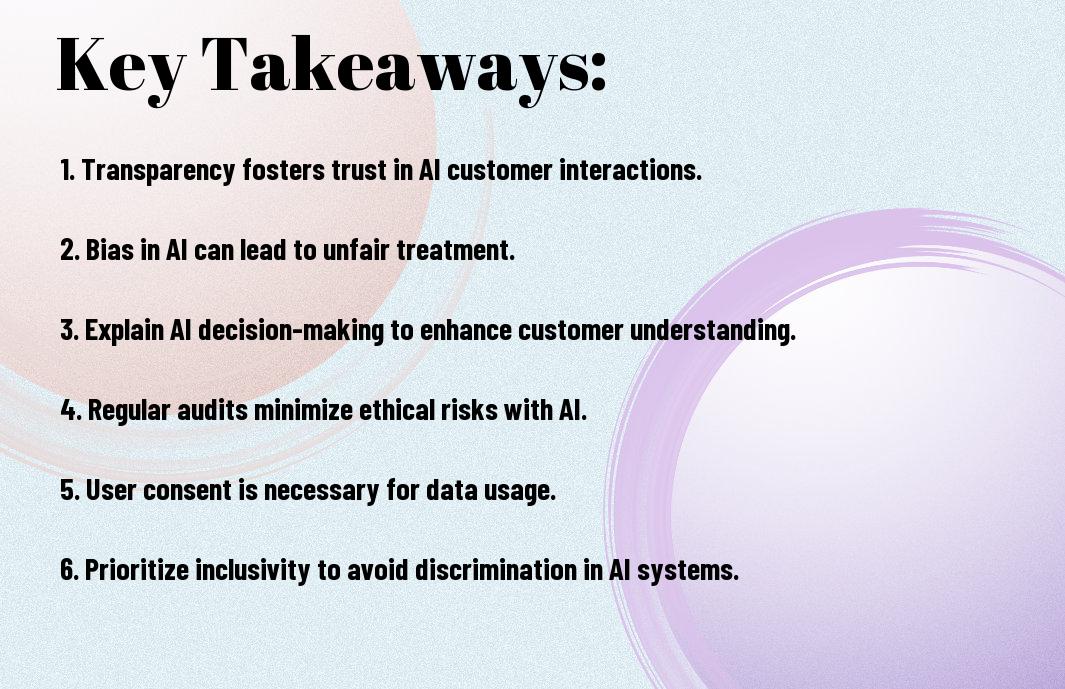It’s vital to understand the ethical considerations surrounding the use of AI in customer interactions, particularly regarding transparency and bias. As you leverage AI technologies to enhance customer engagement, you must be aware of how these systems can influence perception and trust. This post will guide you through significant ethical concerns you should consider, helping you navigate the complexities of AI implementation while fostering ethical practices in your customer interactions.
Key Takeaways:
- Transparency: It’s necessary to ensure that customers are aware when they are interacting with AI, fostering trust and clarity in the relationship.
- Bias Mitigation: AI systems can inadvertently perpetuate biases; addressing these biases is vital to ensure fair and equitable customer interactions.
- Data Privacy: Handling customer data responsibly is imperative, requiring compliance with regulations and safeguarding customer information.
- Ethical Guidelines: Organizations should establish clear ethical guidelines for AI usage in customer interactions to align with their values and societal norms.
- Feedback Mechanisms: Implementing systems to gather customer feedback on AI interactions can help improve the technology and address any ethical concerns that arise.

The Role of AI in Customer Interactions
Before venturing into the intricacies of AI’s involvement, it’s imperative to understand how it reshapes customer interactions. As organizations increasingly integrate AI tools, these technologies facilitate communication, personalize experiences, and streamline responses, leading to enhanced customer satisfaction. Your awareness of how AI enhances these interactions is vital for navigating the evolving landscape of customer service.
Overview of AI Technologies
Beside traditional customer service methods, AI technologies such as chatbots, virtual assistants, and machine learning algorithms are transforming how businesses engage with their customers. These innovations enable organizations to understand customer needs better and automate repetitive tasks, allowing you to provide more efficient and targeted service.
Benefits of AI in Customer Engagement
Behind the functionality of AI in customer engagement lies the potential for significant advantages. By leveraging AI, you can harness data-driven insights to anticipate customer needs, tailor experiences, and streamline processes, all while enhancing operational efficiency.
Customer engagement is elevated through AI by offering personalized communications and timely responses. AI algorithms analyze your preferences and behavior, enabling businesses to tailor promotions and content specifically for you. Moreover, AI reduces wait times through chatbots that provide instant answers to inquiries. This efficiency not only improves your experience but also fosters a sense of connection and loyalty to the brand, keeping you engaged throughout your journey.

Ethical Considerations in AI Deployment
Some ethical considerations must be addressed when deploying AI for customer interactions. Responsible implementation not only enhances the user experience but also mitigates risks associated with transparency and bias. As you navigate these concerns, understanding the implications of your choices will guide you toward more ethical practices in your AI initiatives.
Transparency in AI Systems
Across your AI applications, transparency plays a vital role in building trust with customers. Providing clear information about how AI systems operate helps customers feel more secure and informed in their interactions. By communicating the decision-making processes behind AI, you empower your users to engage with technology thoughtfully.
Managing Bias in AI Algorithms
Bias in AI systems can lead to unfair treatment of certain customer segments. You must actively work to identify and mitigate biases present in your algorithms. This involves evaluating the data used, understanding its impact, and implementing strategies that promote fairness.
Even when you strive to create unbiased AI systems, it’s important to acknowledge that inherent biases can exist in data sources. Therefore, as you review your algorithms, focus on regularly auditing your data and models. Engaging diverse teams in the development process can also help provide varied perspectives, allowing you to notice potential biases that may affect customer interactions. By prioritizing bias management, you contribute to more equitable outcomes for all your customers.
Regulatory Frameworks and Guidelines
Keep in mind that as AI technologies evolve, so do the regulatory frameworks that govern their use. These frameworks aim to balance innovation with ethical considerations, ensuring that customer interactions remain respectful and fair. By staying informed about these regulations, you can better navigate the landscape of AI in customer service while ensuring compliance and fostering trust with your customers.
Current Regulations on AI Usage
Guidelines surrounding AI usage currently vary by jurisdiction. Many regions have enacted laws focusing on data protection and privacy, such as the GDPR in Europe and the CCPA in California. These regulations establish principles around consent, transparency, and the responsible use of customer data, which are important for ethical AI deployment in customer interactions.
Future Directions for Ethical Standards
Across the landscape of AI ethics, it’s clear that evolving standards will emphasize transparency, accountability, and fairness. As frameworks develop, you will likely see a push toward standardized practices that incorporate AI ethics into organizational culture. This means fostering internal policies and training that prioritize responsible AI use and continuously assess for bias and discriminatory impacts.
Plus, future ethical standards may also involve collaboration among industry stakeholders, government bodies, and ethicists to create universally accepted benchmarks. These standards can guide your organization in implementing rigorous auditing processes, ensuring AI systems are functioning ethically and transparently. Emphasizing ethical AI not only aligns with regulatory requirements but also enhances your brand reputation and customer trust, ultimately contributing to long-term success.
The Impact of AI on Customer Privacy
Unlike traditional customer service methods, AI-driven interactions can significantly raise concerns about customer privacy. As businesses increasingly adopt AI to handle customer communications, the amount of collected data grows tremendously, potentially leading to misuse or unauthorized access. This evolution necessitates a thorough understanding of your privacy rights and how companies manage your information to keep their interactions transparent and trustworthy.
Data Collection and Consent
Impact assessment of AI requires examining how effectively companies communicate data collection practices and obtain your consent. Transparency regarding what data is being collected and how it will be used can empower you to make informed decisions about your interactions with businesses.
Safeguarding Customer Information
Before deploying AI systems, organizations must implement robust security measures to protect your personal information from breaches and unauthorized access. This involves establishing encryption protocols, access controls, and regular security audits, ensuring that your data remains safe throughout its lifecycle.
Also, businesses should prioritize regular employee training on data privacy best practices. By doing so, they can foster a culture of security awareness within the organization. Furthermore, incorporating privacy-by-design principles in their AI systems can enhance your confidence in how your data is handled. Transparency in their data policies will further strengthen trust, allowing you to engage with AI-driven services while feeling secure about your privacy.
Case Studies: Successes and Challenges
All over the globe, businesses are experimenting with AI for customer interactions, yielding various outcomes. Here are some notable case studies:
- 1. A major telecommunications company reported a 30% decrease in response times after implementing AI chatbots.
- 2. A healthcare organization experienced a 20% increase in patient satisfaction due to AI-driven appointment scheduling.
- 3. A leading retail brand faced backlash for a biased algorithm that prioritized certain customer demographics, resulting in a public relations crisis.
- 4. A financial services firm improved its customer engagement by 40% through transparent AI policies.
Positive Outcomes of Ethical AI Use
Along your journey in exploring AI’s ethical use, you’ll likely recognize that transparency fosters trust. Companies that prioritize openness about their AI applications often experience enhanced customer loyalty and a better understanding of their services, leading to improved overall engagement and satisfaction rates.
Lessons from Negligent Implementation
Along this path, it’s important to note that mishandling AI can lead to significant challenges. Instances of biased algorithms or unclear communication about AI processes can diminish customer trust and harm brand reputation.
Also, many companies have faced dire consequences from negligent AI implementation. For example, a bank’s AI-driven loan approval system exhibited discriminatory lending practices, leading to legal scrutiny and a damaged reputation. By analyzing such failures, you can identify common pitfalls, emphasizing the need for comprehensive testing, ongoing monitoring, and a commitment to ethical standards in AI use. This awareness helps you safeguard your operations and buildup customer trust moving forward.
Stakeholder Perspectives
Your understanding of the ethical implications of AI in customer interactions greatly enhances the discourse surrounding transparency and bias. Stakeholders in this realm—customers, businesses, and policymakers—each hold unique viewpoints that shape the landscape of AI deployment. By fostering a dialogue among these diverse perspectives, you can better appreciate the complexities involved and advocate for responsible practices that benefit all parties involved.
Customer Views on AI Interactions
An increasing number of customers express mixed feelings about AI interactions. While some appreciate the speed and efficiency, others voice concerns regarding the lack of human empathy and personalized service. Ensuring transparent communication about the use of AI can enhance trust, making customers feel more comfortable with automated interactions.
Business Responsibilities and Obligations
Responsibilities in deploying AI lie heavily on businesses, as ethical concerns about transparency and bias must be addressed proactively. Companies are obligated to communicate clearly how AI tools function, provide avenues for human interaction, and offer recourse for any issues that may arise. This fosters a culture of accountability and enhances customer trust.
Another vital aspect of business responsibilities is continuous monitoring and evaluation of AI systems to ensure fairness and mitigate bias. You should advocate for regular audits and updates to AI technologies and training datasets to guarantee that all customer interactions are equitable and devoid of discriminatory practices. By prioritizing ethical considerations, you not only safeguard your customers but also bolster your brand reputation in a competitive marketplace.
To wrap up
Now that you’ve explored the ethical considerations of using AI for customer interactions, it’s important to prioritize transparency and address bias in your systems. By ensuring clear communication about how AI works and its limitations, you can build trust with your customers. Additionally, continuously monitoring and refining your AI to mitigate any biases will enhance its effectiveness. By taking these steps, you contribute to a more ethical and responsible use of technology in customer relations.
Q: What are the key ethical considerations when using AI for customer interactions?
A: When deploying AI for customer interactions, several ethical considerations arise. Firstly, transparency is vital; customers should be aware that they are interacting with AI, which fosters trust and understanding. Secondly, bias in AI algorithms can lead to discriminatory practices, affecting certain customer demographics unfairly. Organizations must actively work to identify and mitigate these biases to ensure fairness. Lastly, privacy concerns are paramount, as AI systems often collect and analyze personal data. Ensuring that this data is handled securely and ethically is crucial to maintain customer trust.
Q: How can businesses ensure transparency in their AI customer interactions?
A: To foster transparency in AI customer interactions, businesses should clearly disclose when customers are interacting with AI systems, such as chatbots or virtual assistants. Providing straightforward information about the AI’s capabilities and limitations helps manage customer expectations. Additionally, businesses can offer options for customers to escalate their interactions to human representatives whenever desired. This openness not only builds trust but also empowers customers to understand the nature of their engagement with the AI.
Q: What steps can organizations take to address bias in AI used for customer interactions?
A: Organizations can implement several strategies to tackle bias in AI systems. Starting with diverse data collection is key; ensuring the training data represents a wide array of demographics can reduce bias in AI outputs. Regular audits and evaluations of AI algorithms also help identify potential biases. Moreover, involving interdisciplinary teams, including ethicists and representatives from affected communities, in the development and oversight processes can enhance awareness and prompt corrective measures. Continuous monitoring and adjustment are critical in fostering an equitable AI environment for customer interactions.


